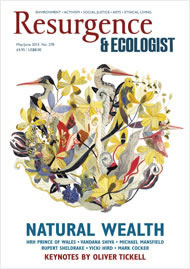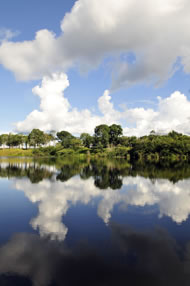Last January I took a dawn walk down the Windrush Valley, close to where I live in the Cotswolds, looking for inspiration for three articles I have been invited to write for Resurgence & Ecologist on rainforests. It was a beautiful, cold, English misty morning and out of the sunshine soon appeared Widford chapel, a minute mediaeval church close to the river.
Inside it was recorded that the chapel had been built within the Wychwood Forest, (Oxfordshire’s largest) covering some 182 square miles (47,000 hectares) at the time of the Domesday Book survey in 1086. Today it is less than a few hundred hectares. The original Saxon inhabitants had been cast out, and in the 1600s, the Wychwood’s grandest trees were logged to build warships, to such an extent that by 1808 a surveyor complained that he could not find “one fine tree of Navy oak”. The wood was then deregulated, allowing farms and roads to move in.
The parallels in the UK with what I have witnessed in my lifetime in rainforests from the Amazon to Borneo are remarkable. The rollback of tropical rainforests over the last 50 years has been characterised by the exclusion of the poor, security fears among governments, global demand for timber, and, more recently, soya to feed Europe’s chickens and pigs, and palm oil for our cosmetics and cookies.
But why should we care what happens to tropical rainforests? The story of the navy surveyor offers us a clue. Admirals then were not worried about trees: what kept them awake at night was security. No big trees in the Wychwoods: no mighty fleet to protect a trading empire. Is there a modern parallel? Could degrading the Amazon or Asia’s forests impact security? To answer that, we need a clear appreciation of what rainforests do for us.
Tropical moist forests cover about 7% of the Earth’s surface. Here evolution has bequeathed to us more than half of all today’s life forms, 60% of it living in the rainforest canopy, a part of the forest I explored in my twenties.
Finding new species up there was easy: most had six legs and rarely came down to the ground. What we did not fully appreciate until decades later was that these 60-metre-high trees powered the largest, most diverse and most powerful atmospheric regulator on the Earth’s surface.
Volatile organic compounds, released by flowers and leaves in the canopy and spiralling upwards into the air – giving the forest its aroma of honey plum cake – oxidise in sunlight to create tiny nuclei around which water droplets form, from moisture drawn in from the oceans.
From the coastline of the Guianas, the Amazon’s trees recycle water many times, cooling the land’s surface. Some falls in the Andes as snow, feeding the eastern slopes with water that benefits Quechua farmers and fills massive hydro dams. The rest, in a vast ‘flying river’ borne on a jet stream, flows thousands of miles south to water the agricultural heartlands of Brazil and even to the La Plata Basin, draining off into the ocean between Argentina and Uruguay. In all, the Amazon releases
8 trillion tonnes of water vapour to the atmosphere each year.
Rainforests are not so much the lungs of the earth: they are more like its heart and liver, pumping heat around the equator and filtering pollutants from the atmosphere, including carbon. Rainforests sequester CO2 through pores in their leaves, combining one atom of carbon with two of hydrogen from water and one of oxygen to make sugar, releasing superfluous oxygen back to the atmosphere.
In this way, a mature rainforest absorbs about a tonne of CO2 per hectare each year, adding up globally to a staggering 1 billion tonnes – just by being there, with no special technology required, and all for free.
Yet, despite the immense importance of these functions, for 30 years the conservation movement has failed to halt deforestation. The reasons are two-fold. Firstly, the argument for saving rainforests has largely been based on a form of ‘existence value’ expounded mainly by people who do not live there or experience the everyday hardships of an empty belly.
Secondly, price signals in markets have created a global free-for-all, which makes forests appear to be largely valueless in modern economic terms unless converted into something else that can be sold, providing hard-pressed governments, businesses and families in forest-owning nations with little choice but to cut them down for cash. To economists, forests are therefore worth more dead than alive.
However, a crucial aspect of this market failure is a lack of recognition of the US$1.4–4.5 trillion annual value of the ecosystem services, provided by forests on a global scale, that underpin climate, food, water, energy and health security for all of us.
Deforestation is predicted to reduce rain in the Amazon region, with climate change a threat multiplier. Regional and global food security will be affected. Brazil’s beef industry, its primary cause of deforestation, needs rain for grass on which to fatten its cattle. The same applies to the immense stretches of farmland created in the Amazon on which to grow soya (exported as a GM-free feedstock to be used in Europe), which are equally at risk from declining rainfall.
What about energy? Seventy percent of Brazil’s electricity comes from hydropower, but the resilience of the nation’s largest rain generator – the Amazon – appears to be neglected in calculations of future energy security. Brazil is investing US$80 billion in hydropower on the Madeira and Xingu rivers, but my enquiries among some of Brazil’s hydrology experts suggest that predicted rainfall and therefore river flows to feed these dams may not fully have considered climate and deforestation impacts. They could simply run dry.
The scale of the potential security risk will be felt globally through dislocated supply chains upon which firms from the US, EU, India and China have come to depend as well as regionally in the Amazon Basin, South East Asia and even the Congo Basin, where big agribusiness is just getting under way.
The question is, what can be done now to halt deforestation, and how can we redirect a tsunami of money and profit to be gained from eroding forests over the next 50 years? For the answers, see my next two articles!








